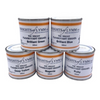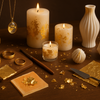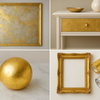Gold Leaf Across the World - Morocco
- by Sam Wozniak
Gold Leaf in Morocco: A Monumental Tradition of Gilding and Restoration
Morocco's cultural legacy is a vibrant tapestry of Islamic art, Andalusian influence, and Berber heritage — all shimmering with touches of gold. For centuries, gold leaf has been used across Morocco’s mosques, palaces, and artisan crafts. Whether in 24 carat or 23.5 carat form, goldleaf remains an essential material in Moroccan aesthetics and preservation efforts.
This article explores the history, uses, and restoration of gold leaf in Morocco — a glowing story of art, identity, and enduring tradition.
The Origins of Gold Leaf in Moroccan Art
The use of gold leaf in Morocco dates back to the early Islamic dynasties, when artisans began incorporating gilding into sacred manuscripts, plaster carvings, and decorative woodwork. Influenced by the Abbasid and Andalusian styles, Moroccan craftsmen mastered the art of embellishing architecture and objects with thin sheets of gold — turning everyday structures into visual masterpieces.
In early Moroccan mosques, gold leaf was often applied to the mihrab (prayer niche), domes, or wood carvings in prayer halls. These gold elements symbolized divine light and purity — core concepts in Islamic spiritual architecture.
Monumental Gilding in Moroccan Architecture
Gilding in Morocco reached its monumental expression during the reign of the Saadian and Alaouite dynasties. Structures such as the Saadian Tombs in Marrakech or the Royal Palaces in Fes and Meknes feature detailed ornamentation using both 23.5 carat and 24 carat gold leaf. The gold was typically applied to hand-carved cedar wood, stucco, or zellige tile frames.
In traditional Moroccan interiors, gold leaf was used not only for religious purposes but also for status and opulence. Ceilings, cornices, and panelling in riads and palaces often gleamed with goldleaf details, reflecting light and amplifying the space’s elegance.
Traditional Techniques and Modern Adaptation
Moroccan gilding was — and still is — an artisanal process. Sheets of 23.5 carat gold leaf are manually pressed onto prepared surfaces with a glue known as "sekkah" or a natural resin base. 24 carat gold leaf, being softer and more brilliant, is typically reserved for the finest decorative elements that require intense shine and symbolism.
Today, Moroccan artisans, especially in Fes, Marrakech, and Tetouan, continue to produce gilded works using ancient methods. In medinas and artisan quarters, you'll find goldleaf calligraphy on leather-bound Qurans, gilded picture frames, and hand-painted pottery.
At the same time, contemporary Moroccan designers have started incorporating gold leaf into modern architecture, fashion, and even culinary presentation — blending heritage with innovation.
Gold Leaf in Restoration Projects
With Morocco’s growing investment in cultural preservation, restoration has become a major focus. The restoration of historical monuments such as the Al-Qarawiyyin Mosque in Fes or the Bahia Palace in Marrakech often includes the careful reapplication of gold leaf to original gilded surfaces.
Restorers typically use 23.5 carat gold leaf to match the durability and tone of historical materials, ensuring authenticity while preserving the original visual splendour. This delicate work supports Morocco’s goal of maintaining its global reputation as a centre of Islamic and Arab-Andalusian heritage.
The Enduring Cultural Significance of Goldleaf in Morocco
Beyond its aesthetic brilliance, gold leaf in Moroccan art reflects deeper meanings — spiritual transcendence, wealth, royal legacy, and artistic mastery. Whether it's used in the restoration of a monumental mosque, the gilding of a traditional doorframe, or a piece of handcrafted jewellery, gold leaf continues to symbolize prestige and devotion.
As Morocco balances preservation with modern expression, goldleaf remains a powerful link between past and present, craftsmanship and culture.
Conclusion:
From the carved cedar ceilings of royal palaces to the delicate script of illuminated manuscripts, gold leaf has left an indelible shine on Morocco’s artistic history. The use of 24 carat and 23.5 carat gold leaf in monumental architecture, gilding traditions, and restoration efforts is not just a visual choice — it is a cultural commitment to beauty, heritage, and identity.






